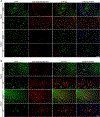Comparison of high-dose intracisterna magna and lumbar puncture intrathecal delivery of AAV9 in mice to treat neuropathies
- PMID: 32289279
- PMCID: PMC7997047
- DOI: 10.1016/j.brainres.2020.146832
Comparison of high-dose intracisterna magna and lumbar puncture intrathecal delivery of AAV9 in mice to treat neuropathies
Abstract
Gene therapy clinical trials for neurological disorders are ongoing using intrathecal injection of adeno-associated virus (AAV) vector directly into the cerebral spinal fluid. Preliminary findings from these trials and results from extensive animal studies provides compelling data supporting the safety and benefit of intrathecal delivery of AAV vectors for inherited neurological disorders. Intrathecal delivery can be achieved by a lumbar puncture (LP) or intracisterna magna (ICM) injection, although ICM is not commonly used in clinical practice due to increased procedural risk. Few studies directly compared these delivery methods and there are limited reports on transduction of the PNS. To further test the utility of ICM or LP delivery for neuropathies, we performed a head to head comparison of AAV serotype 9 (AAV9) vectors expressing GFP injected into the cisterna magna or lumbar subarachnoid space in mice. We report that an intrathecal gene delivery of AAV9 in mice leads to stable transduction of neurons and glia in the brain and spinal cord and has a widespread distribution that includes components of the PNS. Vector expression was notably higher in select brain and PNS regions following ICM injection, while higher amounts of vector was found in the lower spinal cord and peripheral organs following LP injection. These findings support that intrathecal AAV9 delivery is a translationally relevant delivery method for inherited neuropathies.
Keywords: Adeno-associated virus; Intracisterna Magna; Intrathecal; Lumbar Puncture; Neuropathy; Peripheral Nervous System.
Copyright © 2020 Elsevier B.V. All rights reserved.
Conflict of interest statement
Disclosures
S.J.G. declares a conflict of interest with Asklepios Biopharma, from which he has received patent royalties for IP that are not used in this study.
Figures





References
Publication types
MeSH terms
Grants and funding
LinkOut - more resources
Full Text Sources
Other Literature Sources
Medical

